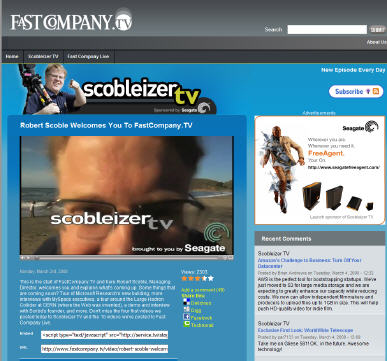-
FastCompany.TV Launches, Scoble at Helm
Yesterday Fast Company magazine officially launched its previously announced FastCompany.TV initiative as "a new kind of business video network." It is another indicator of how broadband is raising the competitive bar in the today's video business.

FC hired Robert Scoble, who ran Scobleizer, an extremely popular technology blog, to be the venture's managing editor. The first programs announced yesterday were "Scobleizer TV," mainly interviews with technology and innovation leaders shot in HD, and "Fast Company Live," which is being shot with a cell phone (yes, a cell phone) and presented in a rough-and-raw, "you're in the front row" experimental style.
FC.TV's launch follows many other magazines' forays into broadband video. I've often said, including in last week's webinar, that print publishers (newspapers and magazines) could well become the most formidable new source of video programming in the coming broadband era. About a year ago, I synthesized some of these thoughts in a report entitled "The Top 40 U.S. Magazines: Learning to Thrive in a Multi-Platform World," in which I asserted that "broadband video offered magazines a once-in-a-generation strategic growth opportunity to leverage their incumbent audiences, trusted brands, editorial expertise and advertising relationships in this new medium." I spoke to Robert yesterday and he concurred with this assessment, offering that "magazines do well in a niche world by understanding targeted audiences, how to serve them and make money at it." He has some previous experience at a 100K circulation title which used a combination of subscriptions, advertising and events to build a very healthy business. Robert believes these kinds of capabilities will serve magazines well in the broadband age.
I spoke to Robert yesterday and he concurred with this assessment, offering that "magazines do well in a niche world by understanding targeted audiences, how to serve them and make money at it." He has some previous experience at a 100K circulation title which used a combination of subscriptions, advertising and events to build a very healthy business. Robert believes these kinds of capabilities will serve magazines well in the broadband age.I asked Robert if he had considered aligning his brand to a broadcast or cable network instead of Fast Company. Though he said he had some conversations, he quickly realized that their approaches were not congruent with his. He saw that traditional networks produce very expensively, with multiple cameras, lights, sets, makeup, etc, all of which creates the lavish look we see on TV. Robert points out that all of this means networks spend a lot of money and time to create just a relatively small amount of actual video (he offered one example he knew of where it took 10 hours to create 2 minutes of video). All of this creates a culture in which executives have a hard time relating to his innovative, low overhead approach.
Conversely, he believes that broadband video must be shot economically, efficiently and creatively, with an eye toward maximizing the ratio of video shot to video aired. As he put it, in a "Google-powered trillion channel world, where each channel may only have 50 or 500 or 5,000 viewers, building media at a low-enough cost enables you to do very well. And the Internet offers the chance to present video that never would have been made in the traditional world."
These sentiments perfectly capture what I see as broadband video's ultimate impact: providing a different consumer experience unencumbered by traditional yardsticks and technologies, with the results being a proliferation of consumer choices and real competition to incumbent players.
Another interesting aspect of FC.TV is that it uses Twistage, a relatively new video publishing and management platform. I had spoken to their CEO David Wadler a couple of weeks ago, and he explained that Twistage is a highly flexible, API-rich platform that he believes is much cheaper than competitors. Robert said he likes Twistage's turnkey ASP approach, which allows FC.TV to outsource just about everything, eliminating a lot of what he called the "drudge work." Wadler told me there are other media customers to be announced soon, so Twistage looks to be an emerging player in this already quite crowded space.
Taken together, FastCompany.TV shows how aggressive magazines can use broadband video to significantly expand the scope of the businesses.
What do you think? Post a comment and let everyone know!
Categories: Magazines
Topics: Fast Company, FastCompany.tv, Robert Scoble, Twistage

